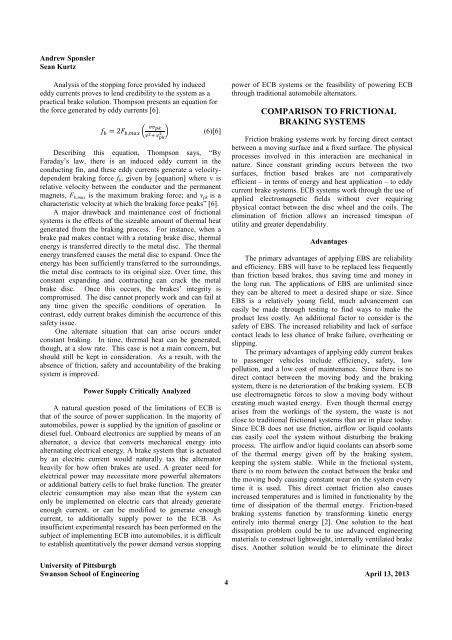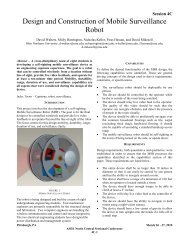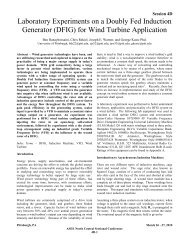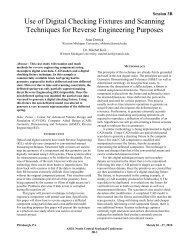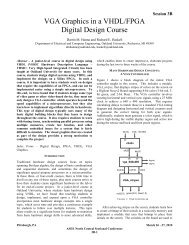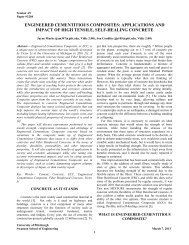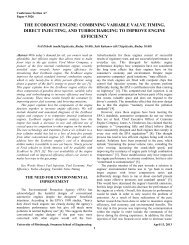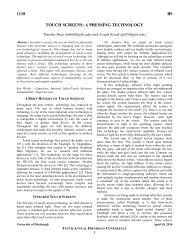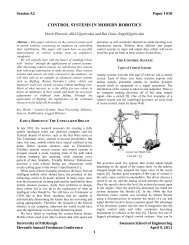ELECTROMAGNETIC & EDDY CURRENT BRAKING SYSTEMS
ELECTROMAGNETIC & EDDY CURRENT BRAKING SYSTEMS
ELECTROMAGNETIC & EDDY CURRENT BRAKING SYSTEMS
You also want an ePaper? Increase the reach of your titles
YUMPU automatically turns print PDFs into web optimized ePapers that Google loves.
Andrew Sponsler<br />
Sean Kurtz<br />
Analysis of the stopping force provided by induced<br />
eddy currents proves to lend credibility to the system as a<br />
practical brake solution. Thompson presents an equation for<br />
the force generated by eddy currents [6].<br />
$ % = 2' %,)*+ , --./<br />
- ! " -<br />
! 0 (6)[6]<br />
./<br />
Describing this equation, Thompson says, “By<br />
Faraday’s law, there is an induced eddy current in the<br />
conducting fin, and these eddy currents generate a velocitydependent<br />
braking force fb, given by [equation] where v is<br />
relative velocity between the conductor and the permanent<br />
magnets, Fb,max is the maximum braking force; and vpk is a<br />
characteristic velocity at which the braking force peaks” [6].<br />
A major drawback and maintenance cost of frictional<br />
systems is the effects of the sizeable amount of thermal heat<br />
generated from the braking process. For instance, when a<br />
brake pad makes contact with a rotating brake disc, thermal<br />
energy is transferred directly to the metal disc. The thermal<br />
energy transferred causes the metal disc to expand. Once the<br />
energy has been sufficiently transferred to the surroundings,<br />
the metal disc contracts to its original size. Over time, this<br />
constant expanding and contracting can crack the metal<br />
brake disc. Once this occurs, the brakes’ integrity is<br />
compromised. The disc cannot properly work and can fail at<br />
any time given the specific conditions of operation. In<br />
contrast, eddy current brakes diminish the occurrence of this<br />
safety issue.<br />
One alternate situation that can arise occurs under<br />
constant braking. In time, thermal heat can be generated,<br />
though, at a slow rate. This case is not a main concern, but<br />
should still be kept in consideration. As a result, with the<br />
absence of friction, safety and accountability of the braking<br />
system is improved.<br />
Power Supply Critically Analyzed<br />
A natural question posed of the limitations of ECB is<br />
that of the source of power supplication. In the majority of<br />
automobiles, power is supplied by the ignition of gasoline or<br />
diesel fuel. Onboard electronics are supplied by means of an<br />
alternator, a device that converts mechanical energy into<br />
alternating electrical energy. A brake system that is actuated<br />
by an electric current would naturally tax the alternator<br />
heavily for how often brakes are used. A greater need for<br />
electrical power may necessitate more powerful alternators<br />
or additional battery cells to fuel brake function. The greater<br />
electric consumption may also mean that the system can<br />
only be implemented on electric cars that already generate<br />
enough current, or can be modified to generate enough<br />
current, to additionally supply power to the ECB. As<br />
insufficient experimental research has been performed on the<br />
subject of implementing ECB into automobiles, it is difficult<br />
to establish quantitatively the power demand versus stopping<br />
power of ECB systems or the feasibility of powering ECB<br />
through traditional automobile alternators.<br />
COMPARISON TO FRICTIONAL<br />
<strong>BRAKING</strong> <strong>SYSTEMS</strong><br />
Friction braking systems work by forcing direct contact<br />
between a moving surface and a fixed surface. The physical<br />
processes involved in this interaction are mechanical in<br />
nature. Since constant grinding occurs between the two<br />
surfaces, friction based brakes are not comparatively<br />
efficient – in terms of energy and heat application – to eddy<br />
current brake systems. ECB systems work through the use of<br />
applied electromagnetic fields without ever requiring<br />
physical contact between the disc wheel and the coils. The<br />
elimination of friction allows an increased timespan of<br />
utility and greater dependability.<br />
Advantages<br />
The primary advantages of applying EBS are reliability<br />
and efficiency. EBS will have to be replaced less frequently<br />
than friction based brakes, thus saving time and money in<br />
the long run. The applications of EBS are unlimited since<br />
they can be altered to meet a desired shape or size. Since<br />
EBS is a relatively young field, much advancement can<br />
easily be made through testing to find ways to make the<br />
product less costly. An additional factor to consider is the<br />
safety of EBS. The increased reliability and lack of surface<br />
contact leads to less chance of brake failure, overheating or<br />
slipping.<br />
The primary advantages of applying eddy current brakes<br />
to passenger vehicles include efficiency, safety, low<br />
pollution, and a low cost of maintenance. Since there is no<br />
direct contact between the moving body and the braking<br />
system, there is no deterioration of the braking system. ECB<br />
use electromagnetic forces to slow a moving body without<br />
creating much wasted energy. Even though thermal energy<br />
arises from the workings of the system, the waste is not<br />
close to traditional frictional systems that are in place today.<br />
Since ECB does not use friction, airflow or liquid coolants<br />
can easily cool the system without disturbing the braking<br />
process. The airflow and/or liquid coolants can absorb some<br />
of the thermal energy given off by the braking system,<br />
keeping the system stable. While in the frictional system,<br />
there is no room between the contact between the brake and<br />
the moving body causing constant wear on the system every<br />
time it is used. This direct contact friction also causes<br />
increased temperatures and is limited in functionality by the<br />
time of dissipation of the thermal energy. Friction-based<br />
braking systems function by transforming kinetic energy<br />
entirely into thermal energy [2]. One solution to the heat<br />
dissipation problem could be to use advanced engineering<br />
materials to construct lightweight, internally ventilated brake<br />
discs. Another solution would be to eliminate the direct<br />
University of Pittsburgh<br />
Swanson School of Engineering April 13, 2013<br />
4


